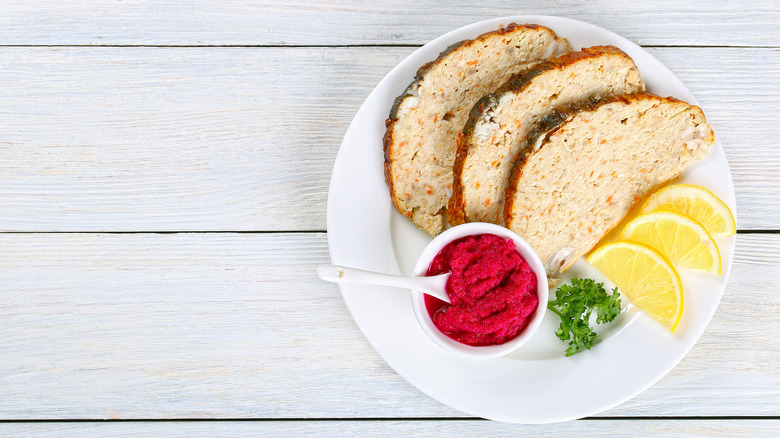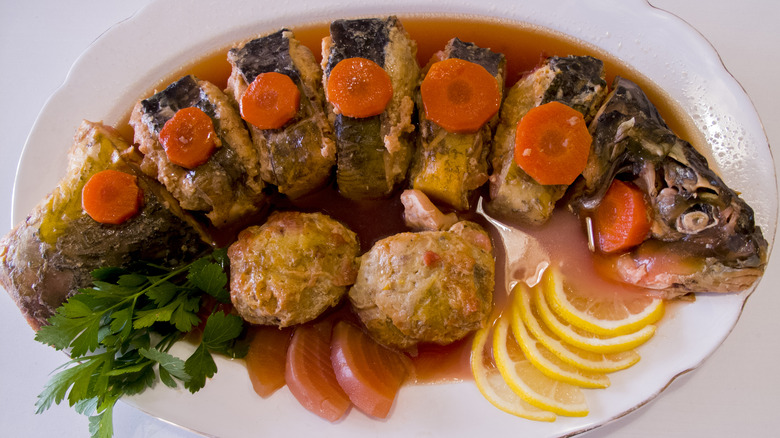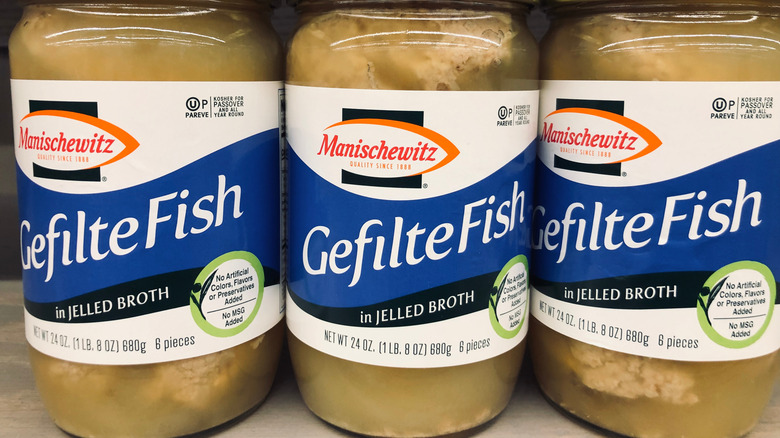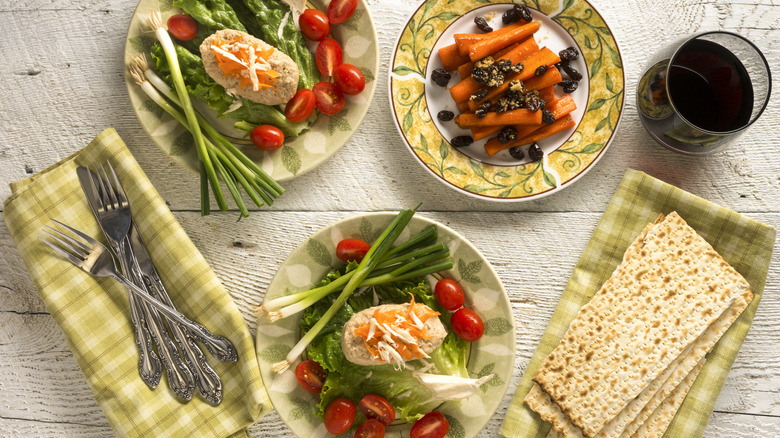What Is Gefilte Fish And How Do You Eat It?
Brisket, latkes, noodle kugel, and matzo ball soup tend to get most of the love during Passover Seders — and understandably so. The warm, hearty, comforting staples are favorites among Jews and non-Jews alike. But one dish is so storied, so emblematic of Jewish culinary traditions, it deserves to be discussed and enjoyed all year long. Yes, we're talking about gefilte fish.
Gefilte fish (pronounced geh-filt) means "stuffed fish" in Yiddish (via The Wall Street Journal) and was traditionally made by Eastern European Jews on special occasions by mincing various types of fish with vegetables and seasonings and stuffing the mixture back into the skin of the whole fish, which was roasted and enjoyed chilled with a side of beet horseradish (via Food & Wine). The dish is enjoyed in many different forms today — the traditional way, shaped into patties, and even from a jar — and, as noted by Chron, sparks fiery debate among steadfast gefilte fans and those who would rather eat literally anything besides "pescatarian's meatloaf" or the "hot dog of the sea."
This is why gefilte fish is a staple in Jewish cooking
Gefilte fish may have been born in Catholic communities of Europe, such as those in Germany, where people ate gefuelten hechden (stuffed pike) in place of meat during Lent, according to My Jewish Learning. By the Middle Ages, the dish had made its way into Eastern European Jewish kitchens, which had plentiful stores of fresh fish in local lakes and rivers. Different countries put their own spin on gefilte fish: Russian and Belarusian Jews dyed theirs pink with beets, Lithuanians added lots of pepper, and Poles and Ukrainians preferred a sweeter version.
Fish in general is prized in Jewish cuisine because it is "a symbol of fertility and a sign of the coming of the Messiah," according to Chron. Gefilte fish is particularly special because it can be made ahead of time and served chilled, which is ideal for Jews who observe the dietary commandments of not cooking hot foods or picking bones from flesh on the Sabbath, explains My Jewish Learning. Finally, gefilte fish allowed people to feed their families with the least expensive parts of the fish and some breadcrumbs, making it reflective of the resourcefulness of Jewish cooking (via Food & Wine).
This is how gefilte fish was traditionally made
If you grew up in a Jewish household, you might remember Barbara Cohen's children's book "The Carp in the Bathtub." The whimsical tale gets its name from the late-1800s and early-1900s trend of New York City Jews storing live fish in their bathtubs, giving up their only bathing space to keep the fish fresh for Passover or Shabbat (via Food & Wine). They would then kill, skin, and debone the fish before sundown in accordance with religious custom (via Chron).
Then began the laborious process of cooking gefilte fish. Home cooks would grind up the flesh of carp, whitefish, mullet, and/or pike and mix it with egg, matzo meal, and vegetables, like carrots. They stuffed the mixture into the intact skin of the whole fish, roasted or poached it, and served it on a platter cold and cut into neat slices — eyes and fins on full display (via Food & Wine).
This is how packaged gefilte fish came to be
In the 1940s, along came a product that allowed Jews to take back their bathtubs and cease their fish-mincing duties: Jarred gefilte fish by the kosher brand Manischewitz (via The Wall Street Journal). Chron notes that the creation — pale fish dumplings suspended in a gelatinous fish broth — would last on the shelf for at least a year. Manischewitz was "a metaphor for America itself — Jewish women no longer had to slave all day long," as American Jewish history professor Jonathan Sarna told The Wall Street Journal.
Others don't speak about the stuff so glowingly. "I ate gefilte fish from the jar as a child. I still have nightmares," kosher blogger Chanie Apfelbaum told The Wall Street Journal. The brand sold 1.5 million jars a year in its heyday, the publication reports, but has seen falling sales and unsuccessful product innovations in more recent years. "In an artisanal food world, Manischewitz is struggling to make its shelf-stable product hook a new, more finicky generation of eaters," the article reads.
Homemade gefilte fish is experiencing a renaissance
Haunted by memories of beige fish balls, some cooks began to embrace store-bought loaves of frozen gefilte fish, which they could doctor up at home with desired vegetables and seasonings and poach in their own stock. These days, though, gefilte fish from scratch is making a comeback. Rallying behind old-school Jewish cooking are Millennials Jeffrey Yoskowitz and Liz Alpern, who co-authored "The Gefilte Manifesto" cookbook and co-founded The Gefilteria, which sells "artisanal" frozen gefilte fish and leads cooking workshops to "[reclaim] the glory of Ashkenazi food" (via Chron).
Unsurprisingly, Jewish chefs also vouch for homemade gefilte fish — but not necessarily the kind where you keep a carp in your bathtub and stuff it after slaughter. By DIY-ing gefilte fish with already skinned and boned fish from the fishmonger, you can season it to your liking, achieve the perfect consistency of "a light matzo ball" and avoid the "gummy and flavorless" stuff from the jar, says HuffPost.
Taste of Home's recipe for gefilte fish quenelles, for example, brightened with salmon and poached in homemade stock, allows you to taste Jewish culinary history in a fraction of the time. "Gefilte fish — whether you like it or not — is all about tradition," Russ & Daughters' owner Niki Russ Federman told HuffPost. "My family has been making and serving gefilte fish for four generations. In so doing, we feel a part of thousands of Seders every year."




